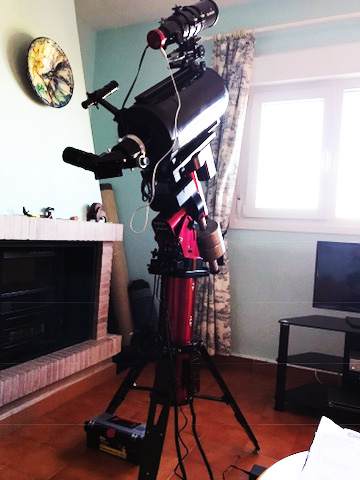Harvest SuperMoon
 Tuesday, September 29, 2015 at 5:24AM
Tuesday, September 29, 2015 at 5:24AM The much awaited Harvest SuperMoon has been and gone. Fortunately it was a clear night here in Leyland. I started taking images of the Moon about 1 a.m. with my 500mm lens on my Sony Alpha A58 DSLR. The event was to last about 5 hours so it meant a pretty sleepless night. I started with an image of the Moon as it was in the south. Of course through the night it was going to move across the sky into the west. To be more precise at 1 a.m. the Moon had just transited the meridian at 12:54 and was at azimuth 181° 20' 42". At 1 a.m. local time (British Summer Time plus 1 hour) the Moon was at an altitude of 36° 27' 57" and as it moved across the sky during the night this was to cause problems with intervening trees meaning that I could not set up a fixed position on a tripod for the night. In fact I had to change position regularly, sometimes trying to image through gaps in tree branches. As a result I handheld the DSLR for the images. If it was a brief event I would have gone to an external site with a clear view of the sky but preferred to stay at home for such a long event. I show below the location of the Moon corresponding to my first image in the constellation of Pisces.
Star chart generated by TheSkyX © Software Bisque, Inc. All rights reserved
The first image that I show below is just before the eclipse started at 01:09:16 BST with the full Moon at an altitude of +36° 25' 58" and azimuth position 184° 08' 47". Remember that azimuth is measured from the north eastwards so this means that the Moon is only 4° 08' 47" west of the meridian. The Moon's RA is 00h 10m 59s so is very close to the First Point of Aries, which is of course currently in Pisces because of precession. This is not surprising because a Harvest Moon is the full Moon nearest to the Autumnal Equinox. In the chart above the blue line sloping downto the right is the Ecliptic. Where it crosses the Celestial equator is the First Point of Aries. As we know the Sun is on the other side of the Earth, close to 180 degrees away from the First Point of Aries. In 12 hours the Sun will be just below the Celestial Equator at noon (UT) as it starts its winter descent following the Autumnal Equinox.
The image was taken with my Sony A58 DSLR at ISO 100, f/6.3 at a shutter speed of 1/640th of a second. Of course as the Moon dims during the eclipse I needed to Increase the ISO setting and increase the time that the shutter is open to capture the light.

This is the chart showing the position of the Moon when the third image was taken.

The third image was taken at 3:29:54 and shows the Moon in full eclipse with the "blood red" colour associated with a lunar eclipse caused by the earth's atmosphere. Sony A58 DSLR at ISO3200, f/6.3 at a shutter speed of 1/8th of a second. A little blurry with a handheld shot at that exposure!
The chart showing the positionof the Moon when the fourth image was taken is shown below

The fourth image shows the Earth's shadow starting to pass from left to right on the Moon. The extra brighness allowed the exposure time to be reduced as well as the ISO. However that means the eclipsed part of the Moon is darker. Sony A58 DSLR at ISO 1600, f/6.3 at a shutter speed of 1/30th of a second.
 [Your Name Here] | Comments Off |
[Your Name Here] | Comments Off | 







